★★★★½
“Thieves Like Us.”

 This is an largely over-looked gem, featuring the future Mrs. Samo Hung (Godenzi – they married in 1995) in a role and performance which are so excellent, as to make you wonder why she apparently quit the cinema the following year [though she does have a cameo in Mr. Nice Guy, appearing in the cooking show audience]. She first came to attention in Eastern Condors and, despite a lack of training, developed a graceful, fluid style of action that works well. Her best known vehicle is She Shoots Straight, but for my money, this is even better.
This is an largely over-looked gem, featuring the future Mrs. Samo Hung (Godenzi – they married in 1995) in a role and performance which are so excellent, as to make you wonder why she apparently quit the cinema the following year [though she does have a cameo in Mr. Nice Guy, appearing in the cooking show audience]. She first came to attention in Eastern Condors and, despite a lack of training, developed a graceful, fluid style of action that works well. Her best known vehicle is She Shoots Straight, but for my money, this is even better.
She plays Hung, one of three sisters who are the business end of a family of thieves. Their guardian decides to pass the clan on to Hung, but another sister, Ngan (Aurelio, also from She Shoots Straight) wants control – she fixes a job so that Hung is captured, then takes over operations, using brute force and murder rather than skill and agility on their robberies. Three years later, Hung’s sentence is ended, but her sister immediately frames her again: to avoid jail, Hung agrees to co-operate with the police and work towards capturing her sister. She discovers Ngan has been hired to steal Napoleon’s death-mask, and the film climaxes with the two sisters battling each other inside the warehouse where the treasure is guarded.
This is almost two plots for the price of one, as on the police side, you have the investigating cop (Ng), who has to keep an eye both on his new partner (Ngai Sing) and a swordplay-novel obsessed nephew (Yuen Biao), who both want to help, but together are as much a distraction as an assistance. This lends itself to the usual goofy and unsubtle HK comedy – for example, Ng stripping to his boxers after believing there’s a bomb hidden in them – though these aspects don’t grate nearly as badly as I’ve seen elsewhere. There are also a bunch of cool moments to the plot which are probably unnecessary, in the larger scheme of things, but are thoroughly satisfying, and suggest someone actually thought the script out, again something not always the case in HK action cinema.
 Godenzi is great, putting over a great combination of coolness and charisma, with a confident attitude that’s wholly justified. It’s established in the first scene that she knows how to push her sister’s buttons, and this comes back into play right at the end. Aurelio, a Filipina powerlifting champion, is a little less adept at acting, but is well-cast as the villainess, with a good sneer. There’s one amazing, politically-incorrect exchange between the characters, when they meet for the first time after Hung’s release from jail. Ngan sneers, “You look plump,” to which Hung replies, “Better than you, with sunburn like a nigger!” Ah, the 1990’s…
Godenzi is great, putting over a great combination of coolness and charisma, with a confident attitude that’s wholly justified. It’s established in the first scene that she knows how to push her sister’s buttons, and this comes back into play right at the end. Aurelio, a Filipina powerlifting champion, is a little less adept at acting, but is well-cast as the villainess, with a good sneer. There’s one amazing, politically-incorrect exchange between the characters, when they meet for the first time after Hung’s release from jail. Ngan sneers, “You look plump,” to which Hung replies, “Better than you, with sunburn like a nigger!” Ah, the 1990’s…
But this one is less about offensive banter, than action scenes which are top-notch, from the opening practice duel between the sisters, through to the final battle – this time for real. It’s particularly inventive as, early on, the sisters have to fight each other without making a sound, to avoid alerting the guards The highlight is, however, probably an amazing fight in a car-park – one of the top locations for mayhem in HK films, right up there with restaurants and warehouses – where everyone bar Aurelio gets involved. Her role as top villain there is delegated to Billy Chow, who went toe-to-toe with Jet Li in Fist of Legend, and he’s one hell of a formidable opponent. The action choreography is credited to Lee King-chu, but I suspect producer Samo Hung had more than a little involvement.
There is little or no depth here, only really what Godenzi brings to the table. But there is, equally, little or no intent of depth either: this was created purely as entertainment, nothing more, and on that level it succeeds admirably. It’s a real shame Godenzi chose not to follow a career as an action actress since, on this showing, she could well have ended up as big a star in the field as Michelle Yeoh.
[A note on spelling. The sleeve says ‘LicenCe’, but the print goes with the S. The former is also grammatically inaccurate, so I’ve gone with the S spelling throughout this article.]
Dir: Billy Chan
Stars: Joyce Godenzi, Agnes Aurelio, Richard Ng, Alvina Kong





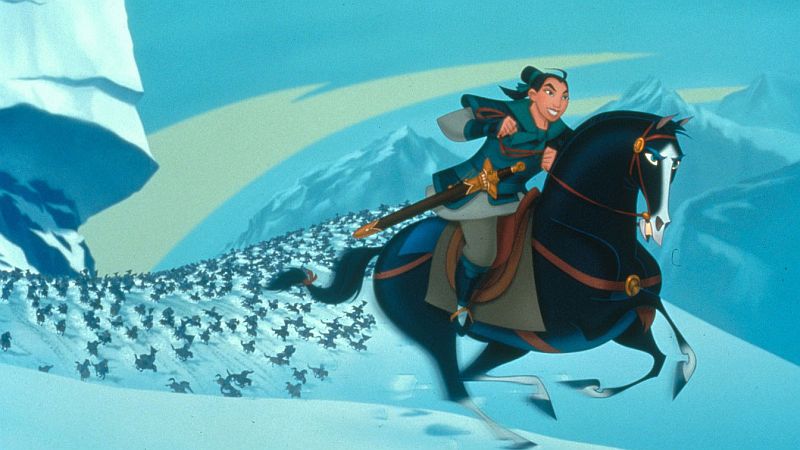
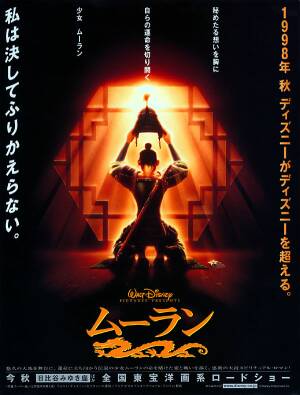 isney movies are not the usual place to find action heroines: their classic woman is a princess, who sits in a castle and waits for someone of appropriately-royal blood to come and rescue her from whatever evil fate (wicked stepmother, poisoned spinning wheel, etc.) that has befallen her.
isney movies are not the usual place to find action heroines: their classic woman is a princess, who sits in a castle and waits for someone of appropriately-royal blood to come and rescue her from whatever evil fate (wicked stepmother, poisoned spinning wheel, etc.) that has befallen her. There’s also no threat of execution when her deception is found out – Chinese culture may perhaps actually have a more tolerant approach to such things, though this is admittedly going only by the likes of Peking Opera, and a good chunk of Brigitte Lin’s career. And, of course, both the romantic angle and amusing sidekick were modern additions. This contrasts sharply with one version of the original, which has the Emperor hearing of Mulan’s exploits, and demanding she becomes his concubine. Mulan commits suicide in preference to this fate, an ending that, for some reason, didn’t make it into the Disney adaptation…
There’s also no threat of execution when her deception is found out – Chinese culture may perhaps actually have a more tolerant approach to such things, though this is admittedly going only by the likes of Peking Opera, and a good chunk of Brigitte Lin’s career. And, of course, both the romantic angle and amusing sidekick were modern additions. This contrasts sharply with one version of the original, which has the Emperor hearing of Mulan’s exploits, and demanding she becomes his concubine. Mulan commits suicide in preference to this fate, an ending that, for some reason, didn’t make it into the Disney adaptation…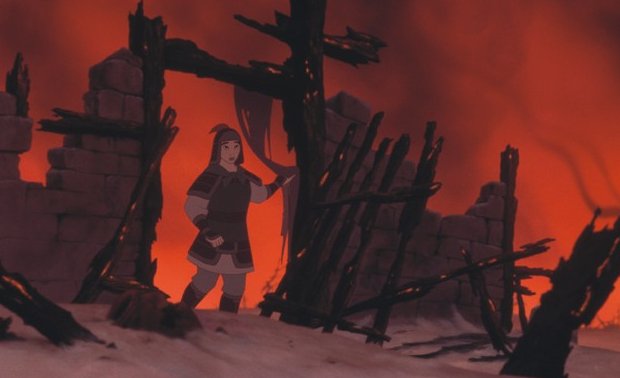 That’s a shame, because the original still has a great deal to offer. Unlike many Disney films, the songs don’t bring proceedings to a grinding halt and are notably absent from the second half of the film. Indeed, the transition is deliberately abrupt: a band of happy, singing warriors is stopped mid-verse when they come across a burnt-out village which the Huns have exterminated (right). It’s a simple, but highly effective moment, where silence says a lot more than any words. [At one point a song for Mulan about the tragedy of war was considered, but this was dropped, along with Mushu’s song, Keep ‘Em Guessing – both decisions which can only be applauded.]
That’s a shame, because the original still has a great deal to offer. Unlike many Disney films, the songs don’t bring proceedings to a grinding halt and are notably absent from the second half of the film. Indeed, the transition is deliberately abrupt: a band of happy, singing warriors is stopped mid-verse when they come across a burnt-out village which the Huns have exterminated (right). It’s a simple, but highly effective moment, where silence says a lot more than any words. [At one point a song for Mulan about the tragedy of war was considered, but this was dropped, along with Mushu’s song, Keep ‘Em Guessing – both decisions which can only be applauded.]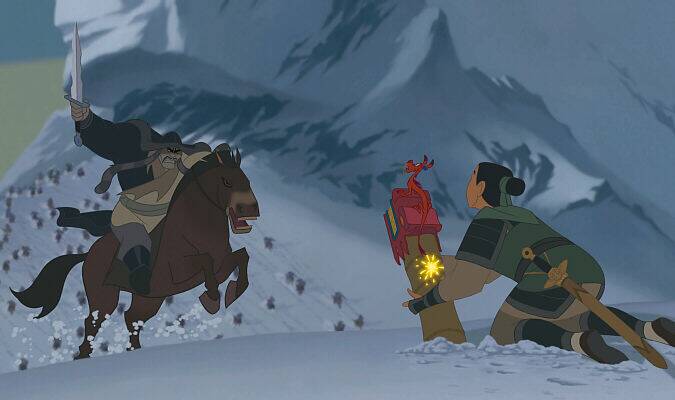 However, personally, I’d say the value of having a clearly non-Caucasian heroine (a first for any Disney film) outweighs relatively minor quibbles about subtext. It may be the last great hand-drawn animated feature from the studio which invented the genre, and all but defined it for sixty years, so I have absolutely no hesitation in recommending this as an empowering and highly entertaining tale for children – of any age, but especially those too young to read subtitles. There aren’t many action heroine films our entire family loves, but Mulan is definitely high on the list.
However, personally, I’d say the value of having a clearly non-Caucasian heroine (a first for any Disney film) outweighs relatively minor quibbles about subtext. It may be the last great hand-drawn animated feature from the studio which invented the genre, and all but defined it for sixty years, so I have absolutely no hesitation in recommending this as an empowering and highly entertaining tale for children – of any age, but especially those too young to read subtitles. There aren’t many action heroine films our entire family loves, but Mulan is definitely high on the list.
 Cutting to the chase; the action is excellent, with several sequences which would be fitting climaxes to any other movie. When you see this one’s finale, you’ll realise why they’re not: Azumi’s master is captured, and an entire town of sword-wielding rogues and assorted scum is in her way, plus villain #1, a rose-wielding psychopath who dresses in white (Odagiri). Settle back, and pass the popcorn. While the swordplay itself is mostly nothing special (save one Very Special decapitation), Kitamura captures it beautifully, the visual highlight being a full circle around two characters – vertically. The sound is also fabulous; you could close your eyes and just listen to the battles.
Cutting to the chase; the action is excellent, with several sequences which would be fitting climaxes to any other movie. When you see this one’s finale, you’ll realise why they’re not: Azumi’s master is captured, and an entire town of sword-wielding rogues and assorted scum is in her way, plus villain #1, a rose-wielding psychopath who dresses in white (Odagiri). Settle back, and pass the popcorn. While the swordplay itself is mostly nothing special (save one Very Special decapitation), Kitamura captures it beautifully, the visual highlight being a full circle around two characters – vertically. The sound is also fabulous; you could close your eyes and just listen to the battles.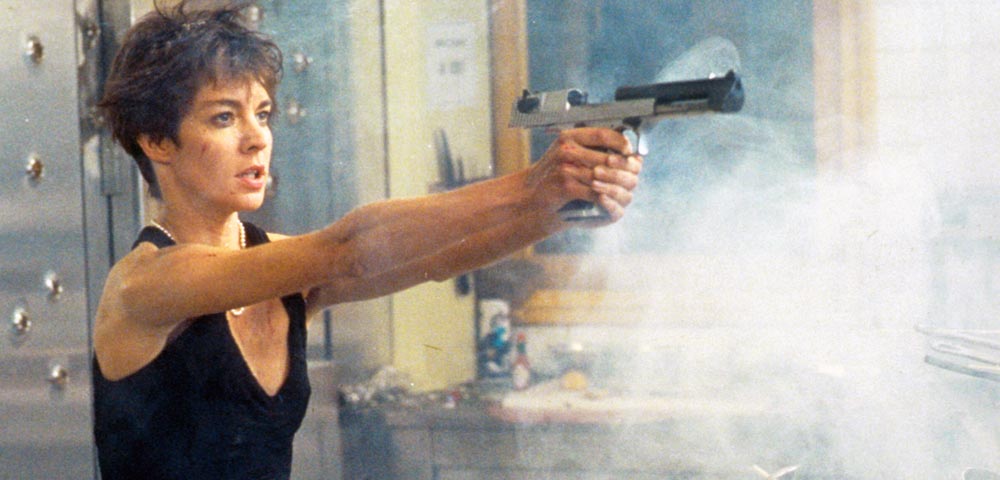
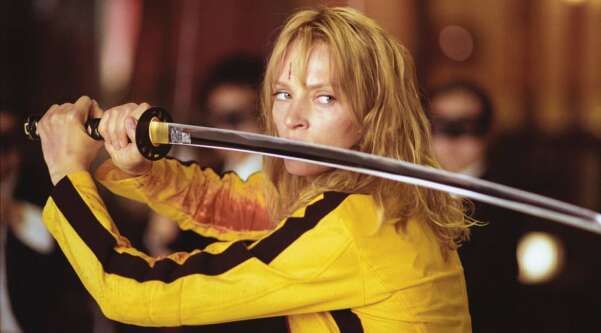
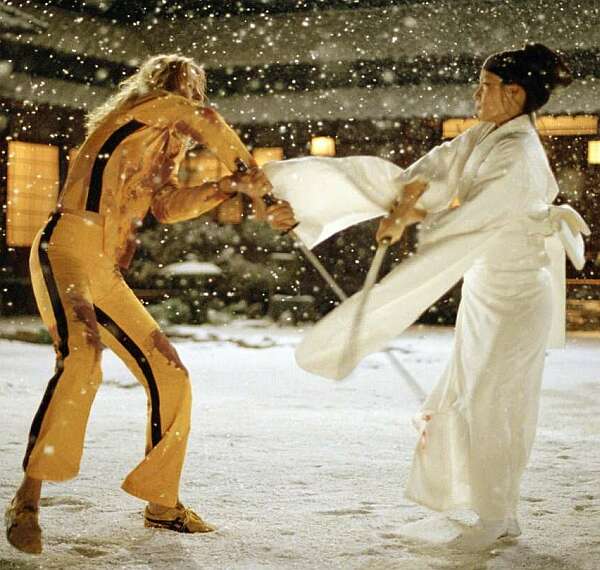 There is also the nasty question of how much of what is praiseworthy, is actually Quentin’s own work. If you’ve seen the infamous Who Do You Think You’re Fooling?, which intercuts clips from Reservoir Dogs with very similar scenes from a Hong Kong movie made several years previously, City on Fire, you’ll know what I mean. I’d rather praise film-makers such as David Cronenberg, who do more than cobble together pieces “borrowed” from other people, no matter how amusingly post-modern the results may be.
There is also the nasty question of how much of what is praiseworthy, is actually Quentin’s own work. If you’ve seen the infamous Who Do You Think You’re Fooling?, which intercuts clips from Reservoir Dogs with very similar scenes from a Hong Kong movie made several years previously, City on Fire, you’ll know what I mean. I’d rather praise film-makers such as David Cronenberg, who do more than cobble together pieces “borrowed” from other people, no matter how amusingly post-modern the results may be.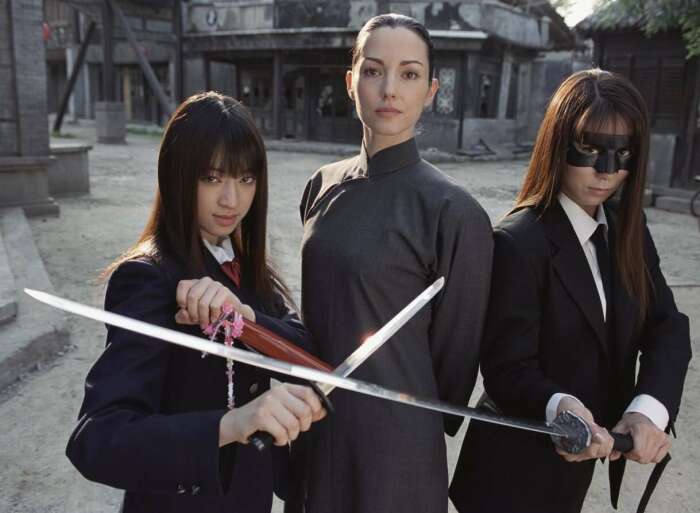 Uma Thurman is The Bride – her character is never named (it’s given a couple of times, but beeped out) – a member of the Deadly Vipers Assassination squad operating under the eye of Bill (David Carradine, not yet seen). When she tries to quit, her marriage is interrupted by the rest of the team, who kill the groom, the priest and even the guy playing the organ. They think they’ve killed the pregnant bride. They’re wrong.
Uma Thurman is The Bride – her character is never named (it’s given a couple of times, but beeped out) – a member of the Deadly Vipers Assassination squad operating under the eye of Bill (David Carradine, not yet seen). When she tries to quit, her marriage is interrupted by the rest of the team, who kill the groom, the priest and even the guy playing the organ. They think they’ve killed the pregnant bride. They’re wrong.



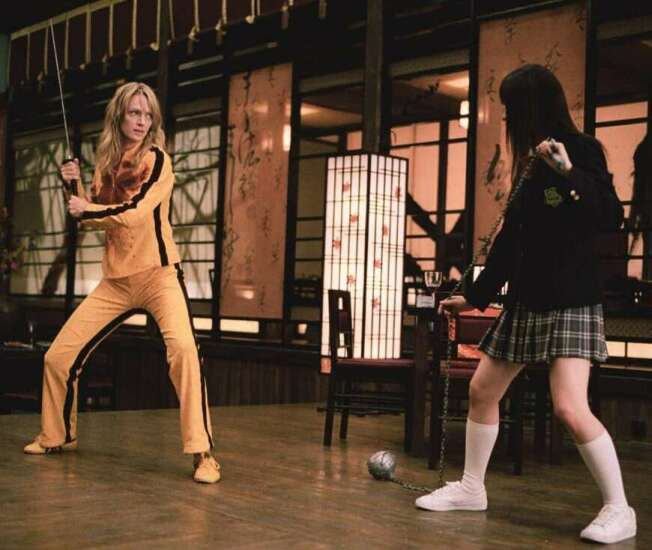 The trailers make this look as if it’s non-stop action, but it isn’t really – there are only a couple of proper set-pieces. The first (cinematically, if not chronologically for the characters) is between The Bride and Green, a brawl around the latter’s house. Despite imaginative use of kitchen utensils, the photography is all wrong, with way too many closeups, leaving it impossible to tell whether there’s any skill – or, indeed, what the hell is going on. I wouldn’t be surprised if this was one of the first things Tarantino shot, since it’s the kind of mistake you’d expect from someone like him, unfamiliar with shooting martial arts.
The trailers make this look as if it’s non-stop action, but it isn’t really – there are only a couple of proper set-pieces. The first (cinematically, if not chronologically for the characters) is between The Bride and Green, a brawl around the latter’s house. Despite imaginative use of kitchen utensils, the photography is all wrong, with way too many closeups, leaving it impossible to tell whether there’s any skill – or, indeed, what the hell is going on. I wouldn’t be surprised if this was one of the first things Tarantino shot, since it’s the kind of mistake you’d expect from someone like him, unfamiliar with shooting martial arts.





















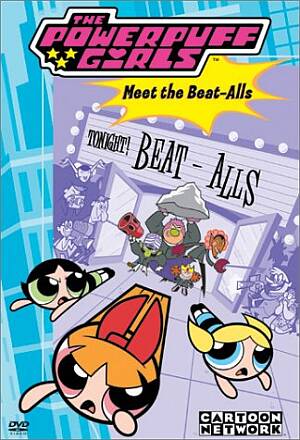 This sprang virtually fully-formed from the twisted mind of McCracken back in 1992, as a student film: even then, he intended it as a series, with most the characters, both heroines and villains, already present. The main change was to the title, the Cartoon Network balking at presenting a show called The Whoop-Ass Girls, and so the “can of whoop-ass” which was originally part of their make-up, was replaced by Chemical X.
This sprang virtually fully-formed from the twisted mind of McCracken back in 1992, as a student film: even then, he intended it as a series, with most the characters, both heroines and villains, already present. The main change was to the title, the Cartoon Network balking at presenting a show called The Whoop-Ass Girls, and so the “can of whoop-ass” which was originally part of their make-up, was replaced by Chemical X.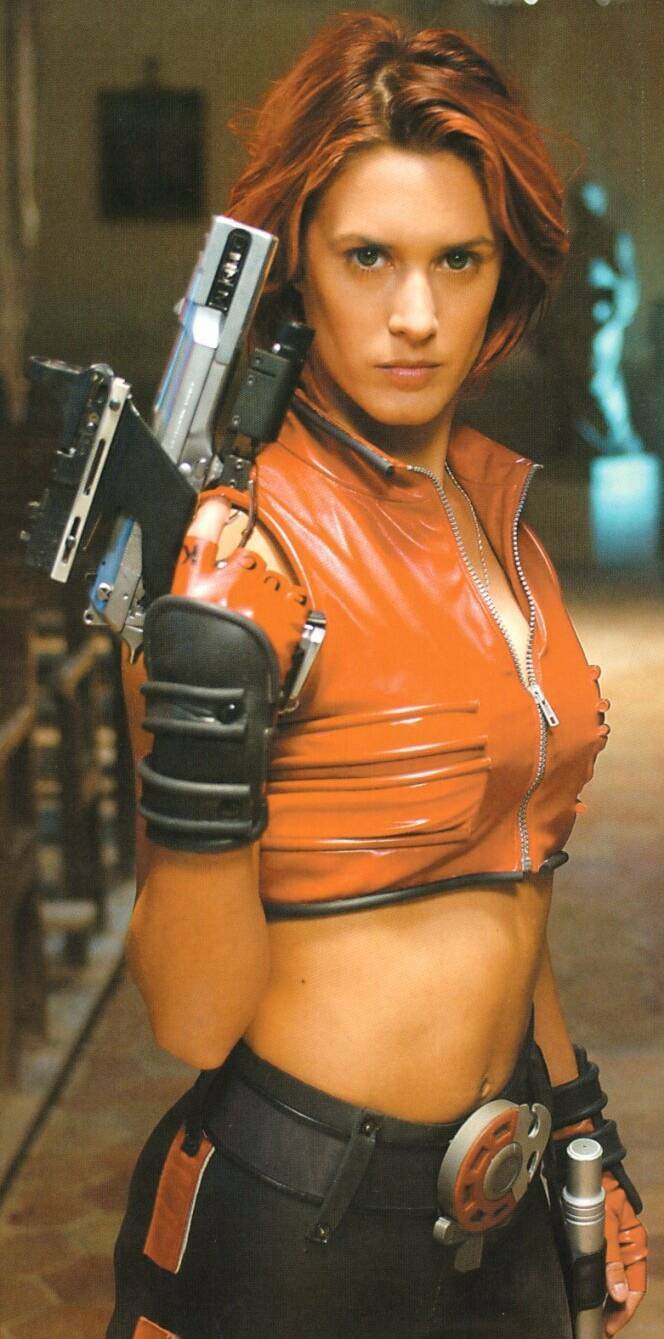
 It has been a long time since we’ve enjoyed a film so much. Right from the start, which shows a bride, in her wedding-dress, being stalked by a demon (or does it?), this grabbed our attention, and hardly let up for a second until the finale. I have to say, the odds are that you will either love this film, or fail entirely to ‘get’ what it’s trying to do and dismiss it as a lame Buffy ripoff. But in our living-room, it got four enthusiastic thumbs-up from the viewing panel, and seems like the perfect complement to beer and pizza.
It has been a long time since we’ve enjoyed a film so much. Right from the start, which shows a bride, in her wedding-dress, being stalked by a demon (or does it?), this grabbed our attention, and hardly let up for a second until the finale. I have to say, the odds are that you will either love this film, or fail entirely to ‘get’ what it’s trying to do and dismiss it as a lame Buffy ripoff. But in our living-room, it got four enthusiastic thumbs-up from the viewing panel, and seems like the perfect complement to beer and pizza.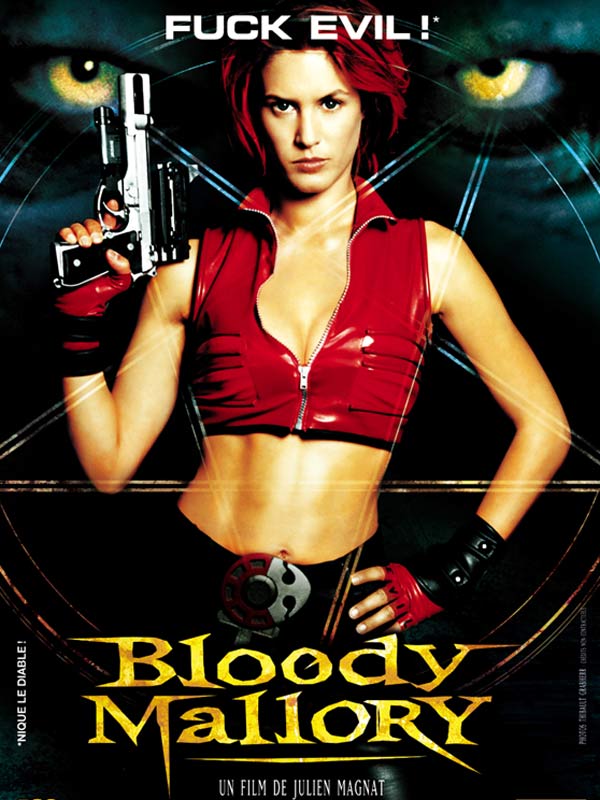 Less effective or interesting are the men, and it’s abundantly clear where Magnat’s passion lies. Father Carras (Collado), the Vatican priest and papal bodyguard is bland and colourless, despite having a name borrowed from The Exorcist. The best is actually Mallory’s demon husband (Julien Boisselier), now stuck in limbo after the murderous end to their marriage. The pair have a relationship which is genuinely touching, in a way which Joss Whedon could only dream of.
Less effective or interesting are the men, and it’s abundantly clear where Magnat’s passion lies. Father Carras (Collado), the Vatican priest and papal bodyguard is bland and colourless, despite having a name borrowed from The Exorcist. The best is actually Mallory’s demon husband (Julien Boisselier), now stuck in limbo after the murderous end to their marriage. The pair have a relationship which is genuinely touching, in a way which Joss Whedon could only dream of.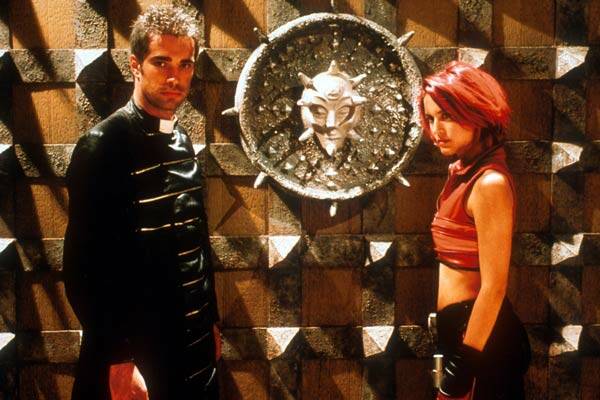 Perhaps what we enjoyed most was the balance Magnat strikes between parody and drama. This is clearly not intended to be taken
Perhaps what we enjoyed most was the balance Magnat strikes between parody and drama. This is clearly not intended to be taken 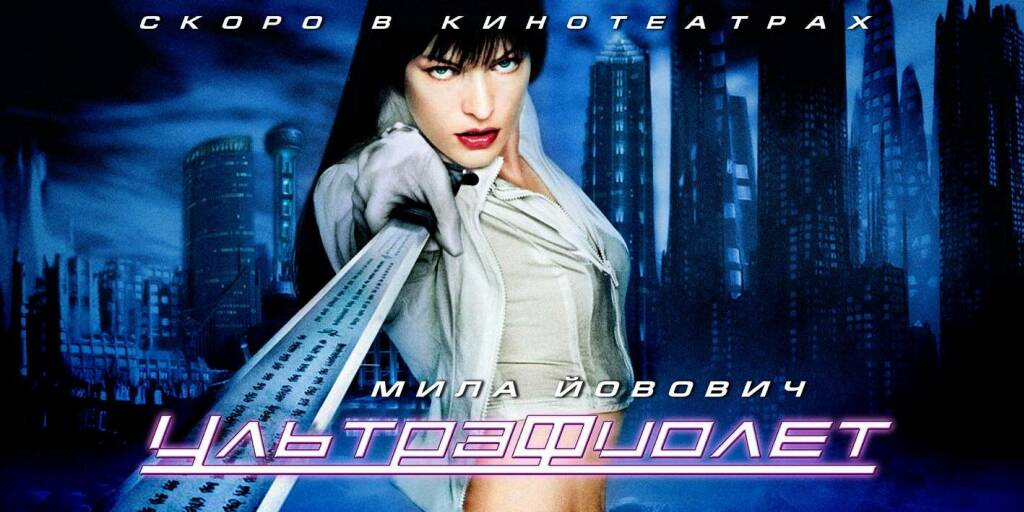 ★★★★½
★★★★½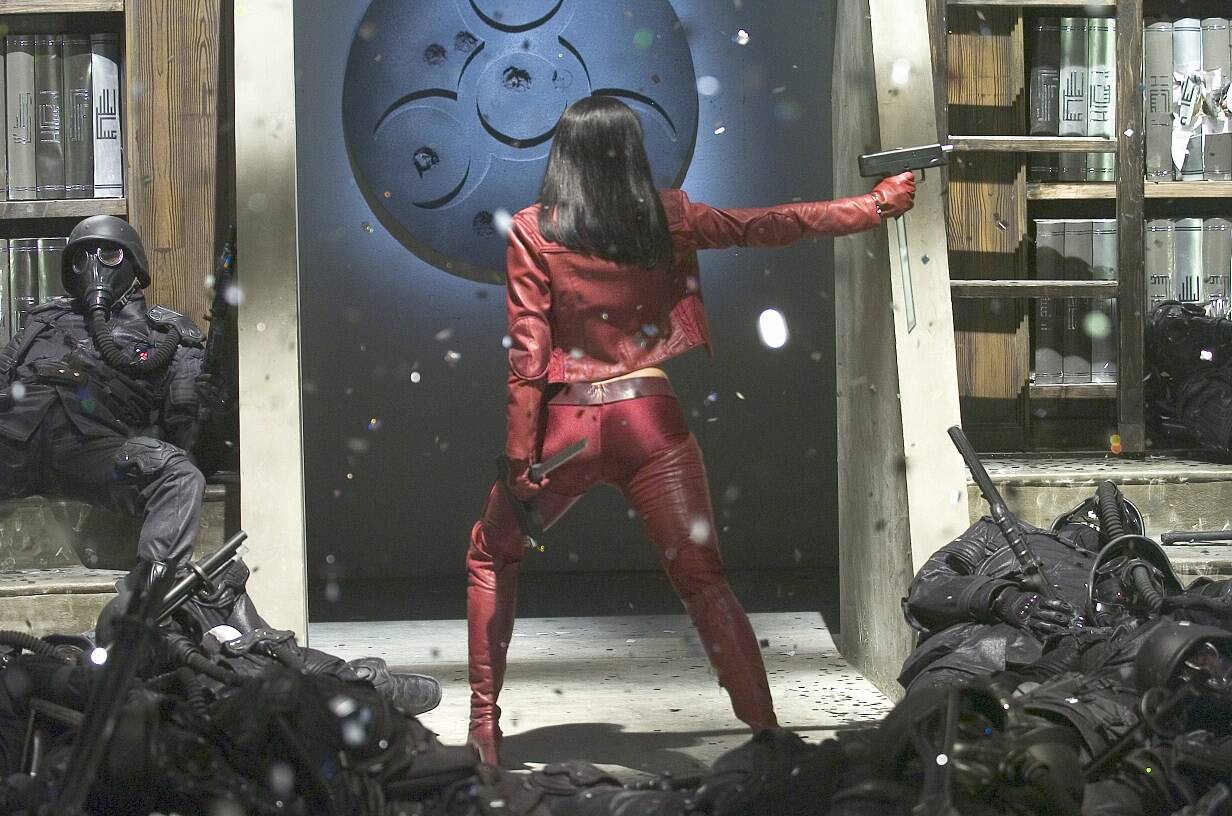 As with Resident Evil, the main asset is Jovovich, who projects just the right mix of chic bad-ass – her belly-button gets so much screen time, it deserved its own credit – with wardrobe and hair changing colour in synch with her mood [and, I believe, it’s far more likely nanotech will be used for this kind of thing than, say, curing cancer] When her co-vampires prepare to take her on, pointing out they’re just as fast and strong as she is, her response is, “Yeah, but are you as pissed-off as I am?”. It’s hard to imagine any other actress who’d come out with such a cheesy line and get away with it.
As with Resident Evil, the main asset is Jovovich, who projects just the right mix of chic bad-ass – her belly-button gets so much screen time, it deserved its own credit – with wardrobe and hair changing colour in synch with her mood [and, I believe, it’s far more likely nanotech will be used for this kind of thing than, say, curing cancer] When her co-vampires prepare to take her on, pointing out they’re just as fast and strong as she is, her response is, “Yeah, but are you as pissed-off as I am?”. It’s hard to imagine any other actress who’d come out with such a cheesy line and get away with it.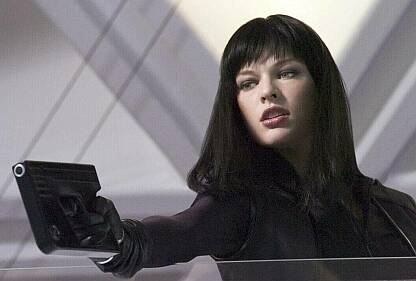 Otherwise, however, the action is excellent, CGI enhancing the impact of the fights. There is a certain sameness, it must be admitted – Violet faces multiple opponents and kicks their arses from here to next week – but Wimmer takes this basic theme and runs enough variations on it that it doesn’t become boring. Visually, it is hard to work out where the sets stop and the plentiful effects work begins (to some extent, that’s true of the supporting cast as well, who don’t have really have much to do, and may be avatars). Either way, it looks fairly good, given the budget: as noted, it isn’t going for photorealism, though the motorcycle chase did look more like an Xbox game. But even little things like disposable mobile phones, indicate genuine thought has gone into the edges. Perhaps more so than the plot, truth be told.
Otherwise, however, the action is excellent, CGI enhancing the impact of the fights. There is a certain sameness, it must be admitted – Violet faces multiple opponents and kicks their arses from here to next week – but Wimmer takes this basic theme and runs enough variations on it that it doesn’t become boring. Visually, it is hard to work out where the sets stop and the plentiful effects work begins (to some extent, that’s true of the supporting cast as well, who don’t have really have much to do, and may be avatars). Either way, it looks fairly good, given the budget: as noted, it isn’t going for photorealism, though the motorcycle chase did look more like an Xbox game. But even little things like disposable mobile phones, indicate genuine thought has gone into the edges. Perhaps more so than the plot, truth be told.








































